New Book Releases / Summer 2023
If you would like to alert us to a recent or forthcoming film publication for the next round-up in winter, please contact us here. For notes on more books, see David Hudson’s monthly round-up at Criterion’s The Daily.

Two new books grew out of retrospectives curated by the excellent Portuguese programmer Ricardo Matos Cabo, one retrospective of the work of Jean-Marie Straub and Danièle Huillet in London in 2019 and another one of the films of Peter Nestler that he programmed together with Lucía Salas at this year’s Punto de Vista festival last March. The Cinema of Danièle Huillet and Jean-Marie Straub looks back over the complete oeuvre of the couple. Edited by Martin Brady and Helen Hughes, this volume was published last April in the Moving Image series of Legenda (MHRA). You can find the full table of contents on their website.
Jean-Marie Straub once strikingly characterized Peter Nestler as a “Documentarian Not Reconciled”. Part of Punto de Vista’s exquisite publication series, El cine de Peter Nestler. Se acercan otros tiempos comes in two Spanish-language volumes. The first is a miscellany of documents from and about both Peter and Zsóka Nestler, his collaborator and partner. The second volume is a reproduction of Bauern malen Bilder [Peasants Paint Pictures], a 1974 book with photographs and texts by Peter Nestler and Reinald Schnell. This is the first non-German edition and the first time that the paintings are reproduced in color.
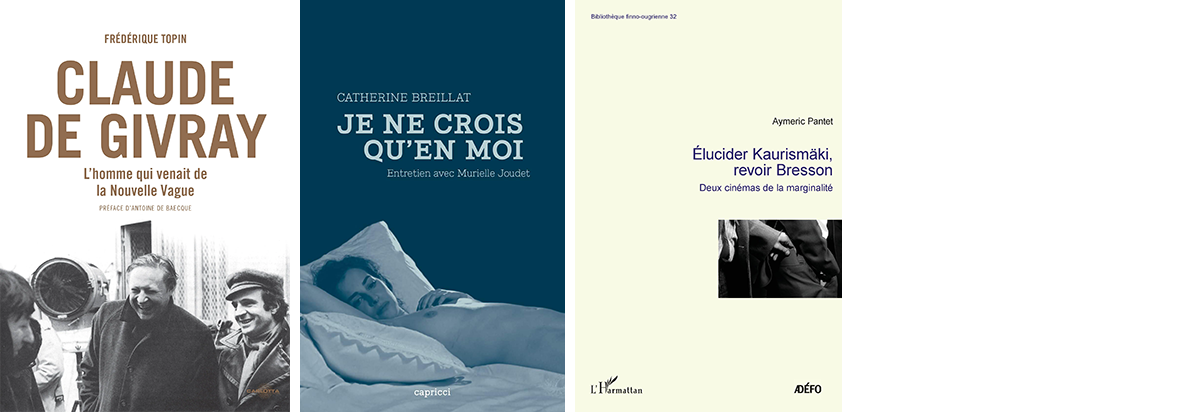
Since the death of Jacques Rozier last month, Luc Moullet is one of the last ones left of the Nouvelle Vague and the first generation of Cahiers critics. Moullet once replied to such a question: “There’s still Claude de Givray,” whom he also celebrated in a text in Trafic. This lesser known, ninety-year-old filmmaker and member of the band of Cahiers tells his life story in the autobiography that has been released from Carlotta last April. Written by his friend and collaborator Frédérique Topin, Claude de Givray: L’homme qui venait de la Nouvelle vague includes a foreword by Antoine de Baecque. Published the same month, the first issue of Cahiers’s new hors-séries collection – dedicated to François Truffaut – also features an interview with de Givray, who was Truffaut’s assistant and co-writer.
Luc Moullet also bridged a gap between the Nouvelle Vague and the following generations in his tender 2012 portrait of Cathérine Breillat in the ‘Cinéma de notre temps’ series. “It was through the New Wave that I became aware that one could be young, unknown, not a professional filmmaker and still make films. They taught me that cinema is a desire, not a school,” Breillat once said. At the end of August, Capricci will release Catherine Breillat. “Je ne crois qu’en moi”, a monograph based on a series of interviews with the critic Murielle Joudet.
The book will be out in the build-up to the French mid-September release of Breillat’s new film L’été dernier [Last Summer] and the director-approved 4K remaster of her debut, Une vraie jeune fille (1975/1999) later on. For many critics Breillat’s film stood out from this year’s Cannes competition together with another return: Aki Kaurismäki’s Fallen Leaves. “In the film, I tip my too-small hat to my own film gods Bresson, Ozu and Chaplin,” Kaurismäki said. The film scholar Aymeric Pantet published a 444-page book that explores the oft-mentioned but never thoroughly analyzed statement that there is something Bressonian in Kaurismäki’s films. Elucider Kaurismäki, revoir Bresson has been available from L’Harmattan since April.
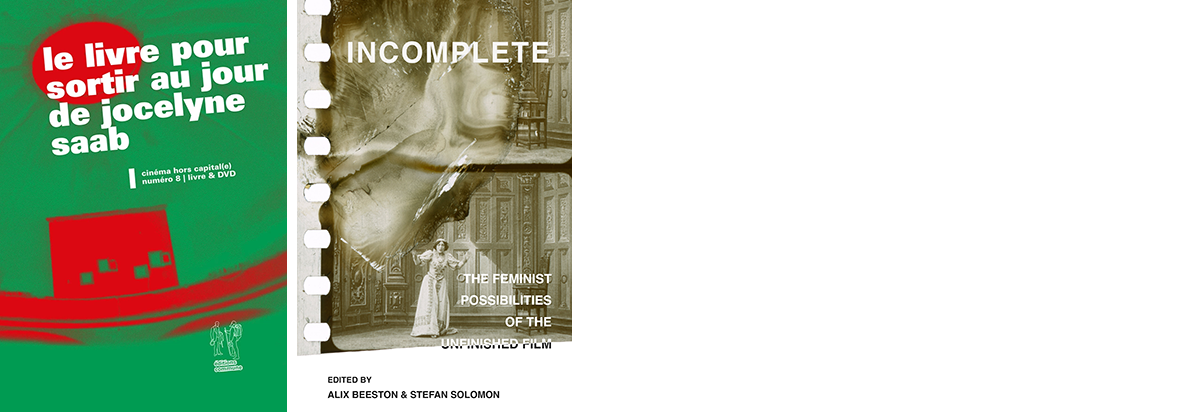
Last April, Le Livre pour sortir au jour de Jocelyne Saab appeared in Les Editions Commune’s Cinéma hors capital(e) collection. Three authors analyze the poetic and political gestures of this unclassifiable French-Lebanese filmmaker over the course of more than forty years of creative work, documentary and fiction, for a large part devoted to the destruction of her country, Lebanon. The researcher and film restorer Mathilde Rouxel resituates the filmmaker’s career historically and politically. The historian Saad Chakali goes through all her work up to the latest fiction films and opens our eyes to a new reading. The filmmaker Jean-François Neplaz offers an article on the writing of history through cinema. This 200-page book contains photographs and pieces from the archives of Saab, Etel Adnan and Roger Assaf, and two DVD’s: Beyrouth jamais plus (1976) and Une vie suspendue (1985).
The film restorer and researcher Mathilde Rouxel also contributed a chapter on Jocelyne Saab to the new collection, Incomplete: The Feminist Possibilities of the Unfinished Film. Published this month from University of California Press, this book establishes unfinished film projects – abandoned, interrupted, lost or open-ended – as an ideal site for revealing the lived experiences, practical conditions and institutional realities of women’s film production. Among other pieces, the volume includes an interview between Peggy Ahwesh and Leo Goldsmith and chapters on the work of Leslie Thornton and Kathleen Collins. The book is co-edited by Alix Beeston and Stefan Solomon. Together with Lúcia Nagib, the latter also co-edited The Moving Form of Film: Historicising the Medium through Other Media, appearing later this month from Oxford University Press.
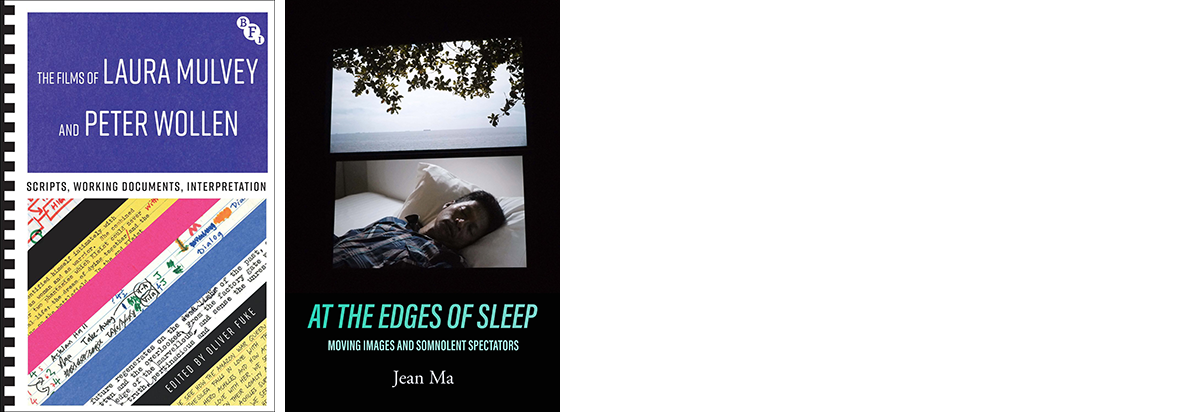
More new publications shed light on the important creative roles women played in the film industry, such as Women and New Hollywood, a collection that came out from Rutgers University Press last month. In the closing chapter, “Feminism, Auteurism and the 1970s in Theory,” Maria Pramaggiore focuses on the legacies and afterlives of Laura Mulvey’s ‘Visual Pleasure and Narrative Cinema’, situating the seminal essay in relation to its “sibling theoretical construct”: auteurism.
A new collection of Laura Mulvey and Peter Wollen’s film scripts that was published last month by the BFI vividly evokes the close connection between their influential work as theorists and their work as filmmakers. The Films of Laura Mulvey and Peter Wollen includes scripts for all six of their collaborative films, Wollen’s solo feature film, Friendship’s Death (1976), and Mulvey’s later collaborations. Each text is followed by a new essay by writers such as Nora M. Alter, Volker Pantenburg, B. Ruby Rich and Sukhdev Sandhu.
Laura Mulvey and Peter Wollen’s work brought feminist, semiotic and psychoanalytic concerns together. In At the Edges of Sleep: Moving Images and Somnolent Spectators, the film and art historian at Stanford, Jean Ma, examines the work of Apichatpong Weerasethakul by bringing together an array of interlocutors – from Freud to Proust, George Méliès to Tsai Ming-liang, Weegee to Warhol – to rethink moving images through the lens of sleep. The book’s unconventional structure – eleven short chapters that overlap in multiple ways – allows for many detours away from Apichatpong. Although the book was already published at the end of last year, we want to highlight the fact that it’s available to download for free as an e-book or pdf.
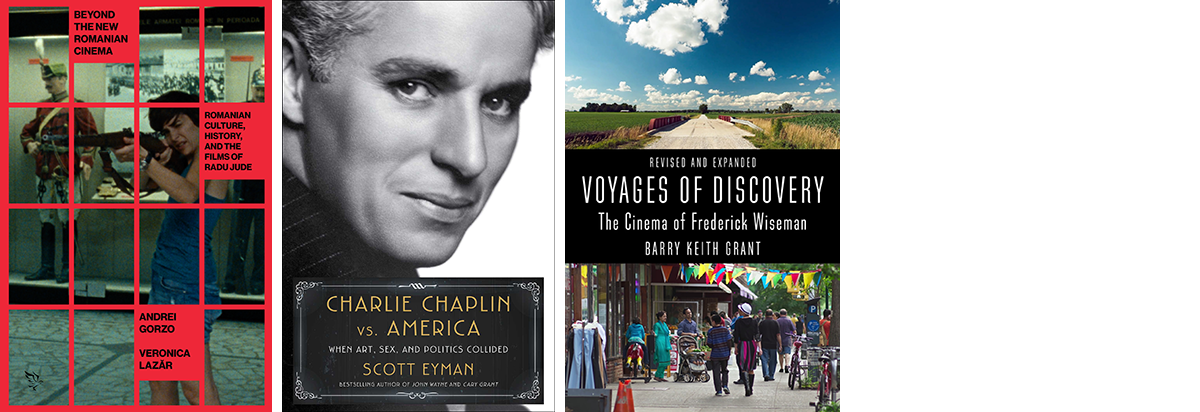
A couple months back, the film scholar and critic Andrei Gorzo contributed a text to Sabzian’s Passages section about Hugo Pratt’s Corto Maltese comics and his youth in Ceaușescu’s Romania. Together with Veronica Lazăr, he now wrote a monograph on the films of Radu Jude that will be available to order this month, Beyond the New Romanian Cinema: Romanian Culture, History and the Films of Radu Jude. The critic and professor emeritus James Naremore calls it an “impressive, invaluable study of the filmmaker” and “highly recommends” it for its acute critical observations and its intelligent, informed commentary on Romanian cinema, culture and society in general.
Forthcoming in October from Simon & Schuster, Charlie Chaplin vs. America: When Art, Sex and Politics Collided will be the new book of film historian Scott Eyman, also the biographer of Mary Pickford, Ernst Lubitsch and Cary Grant, among others. Eyman describes it as “a deep dive into why and how Chaplin was kicked out of his adopted country” and “a story that hasn’t been told with any depth or complexity until now.”
Please take note that Barry Keith Grant’s authoritative study of America’s foremost chronicler of institutions and governments has been out in a revised and expanded edition from Wallflower Press since last month. Originally published in 1992 from University of Illinois Press, the updated second edition of Voyages of Discovery: The Cinema of Frederic Wiseman adds new material exploring the documentarian’s work since the 1990s. As the author writes in the introduction: “Since then, Wiseman has made an astonishing twenty more films.” His most recent film, Un couple (2022), is also included. Three new chapters have been added and all the original chapters have been revised to some extent.

Next up are two new monographs on filmmakers who rose to fame in the 1990s American independent film scene. In Gus Van Sant: Cinéaste de l’infinitif, however, Florian Tréguer focuses on the filmmaker’s Tetralogy of Death made during the first decade of this century (Gerry, Elephant, Last Days and Paranoid Park). In these films, the author discerns a stylistic mode that he calls “the infinitive,” with impersonal and abstract qualities emerging in the image and sound, freed from subject and time but densely invested by the virtual and fantasy. The book appears this month as part of the Focale(s) series of the publisher Passage(s).
On the occasion of their retrospectives of the work of Whit Stillman and Paul Vecchiali in July, the FIDMarseille festival launches the joint monograph series One Two Many in collaboration with Fireflies Press and Editions de l’oeil. Alongside a new, career-spanning interview, Whit Stillman: Not So Long Ago features essays, archival documents and a selection of Stillman’s own personal writings on cinema. Offering a range of unique perspectives on his oeuvre, the publication brings together critics, filmmakers and scholars from the French- and English-speaking worlds: Nick Pinkerton, Haden Guest, Cyril Neyrat, Charlotte Garson, Beatrice Loayza, Serge Bozon and Félix Rehm. If you pre-order the English edition from Fireflies Press, you’ll receive your copy in July, ahead of the official September publication date. The French edition will be out in July from Editions de l’oeil, together with the other publication in the series, Paul Vecchiali: Once More. This collection opens with a portrait of Vecchiali by Marie-Claude Treilhou, followed by four essays on his work. The second part offers a selection of Vecchiali’s own texts on film(makers). The last part presents a new interview dating from February 2023 with some of his actors. We’re not certain if Fireflies Press will also release an English edition of this book.
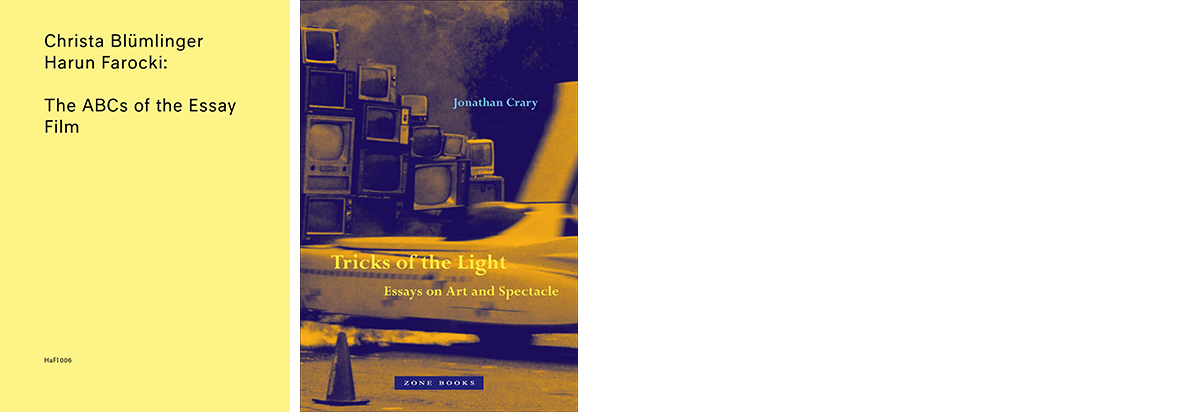
Last April, the Harun Farocki Institut announced a free PDF release of Christa Blümlinger & Harun Farocki’s The ABCs of the Essay Film (EN / GE). Compiled in Autumn and Winter 2013-2014, this dialogical ABC contains twenty-six short paragraphs in which Farocki reacts to key terms suggested by Blümlinger. The booklet is complemented by a short text by Farocki on the essay film which was published in 1987. Currently out of print, the pamphlet will be available for a limited period of time. It’s still there at the time of writing, so grab your chance.
Forthcoming from Zone Books, Tricks of the Light: Essays on Art and Spectacle brings together a selection of essays on media systems and contemporary art by Jonathan Crary, a leading theorist of modern visual culture and the author of Techniques of the Observer (1990) and 24/7: Late Capitalism and the Ends of Sleep (2013). The collection also includes his reflections on filmmakers Fritz Lang, Stanley Kubrick, Jean-Luc Godard, David Cronenberg and others. The book will be published in the US and the UK in September and October, respectively.
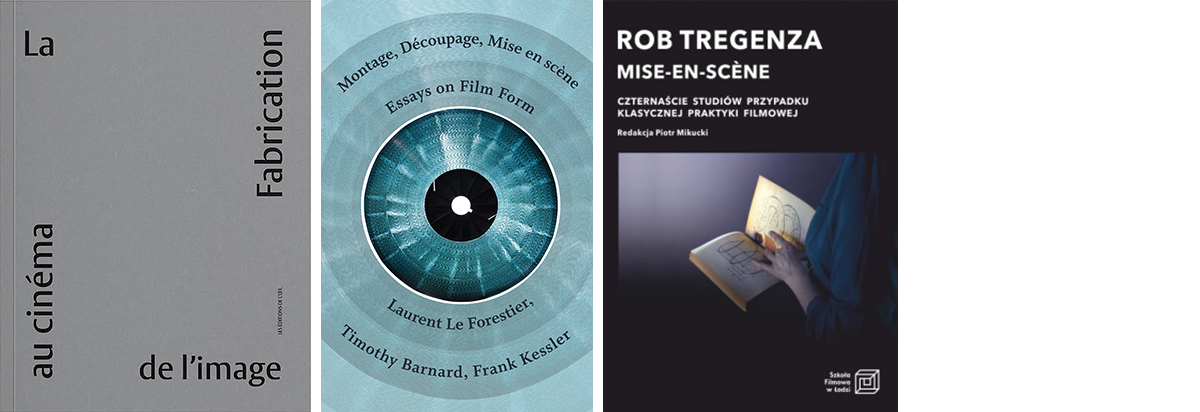
Caroline Champetier, who worked as a chef opérateur for Jean-Luc Godard and many others, co-edited La Fabrication de l’image au cinema together with teacher and researcher Giusy Pisano. In the book, a large selection of cinematographers and directors of photography – including Champtier herself, Agnès Godard, Claire Mathon and Hélène Louvart, among many others – talk about their profession and their work with Claire Denis, Mati Diop, Jean-Luc Godard, Mikhaël Hers, Alice Rohrwacher and others. You can find the full table of contents here. The contributors address the question of how one makes an image in cinema. How and why do you choose a camera, a particular set of lighting and machinery, a particular sensitivity of film, etc.? Not only what tools, but also with whom: the director, the set designer, the actors, your own camera crew, etc.? And when: before, during, after or right up to color timing? Why ultimately this image rather than another, this frame format, a fixed or a moving camera; why shoot in spring or winter, why apply makeup or not; how far can we go and who or what allows it? The book has been out since April from Editions de l’oeil.
The latter publication touches on some of the questions dealt with in Caboose’s new edition of Montage, Découpage, Mise en scène: Essays on Film Form released last April. The versions of Timothy Barnard’s Découpage and Frank Kessler’s Mise en scene have been revised and expanded. The Montage part consists of a previously unpublished essay by Laurent Le Forestier, which is not the same as Jacques Aumont’s homonymous book-length essay from Caboose that already appeared in a second revised and expanded edition in 2020.
While on the topic, let’s note that the filmmaker Rob Tregenza has also written a mise-en-scène book, Mise-en-scène: Fourteen Case Studies of Classic Film Practice. It was released in April by the publishing house of the Film School in Łódź and is edited by its dean, Piotr Mikucki. The filmmaker and lecturer Rob Tregenza was the director of photography of Béla Tarr’s Werckmeister Harmonies (2000) and made four feature films, most famously Talking to Strangers (1988), his feature film debut. Last April, a retrospective of Tregenza’s work was programmed at MoMA by Dave Kehr, who calls the publication “an unclassifiable alloy of textbook and theory. Staying in the tradition of Eisenstein’s and Bresson’s reflection, he begins with film practice and moves to universal insights. It’s not an ordinary textbook for novice filmmakers. Tregenza rather presents his philosophy of cinema. “It’s all my theoretical work of the last ten to fifteen years.” Unfortunately, the book will only be available in Polish for now.

Back to the Montreal-based, independent publisher Caboose. In April, they released a new edition of The André Bazin Reader. Forthcoming this summer, Reading with Jean-Luc Godard will be a one-of-a-kind volume: fifty specialists engage with 109 individual texts by 90 authors found throughout Godard’s work. Three-page mini essays will introduce the books to the reader and unlock their importance to Godard. The theorist Fredric Jameson, who has followed the work of Godard since the beginning, contributes both a preface and a coda. On the publisher’s website, you can already find a list of the authors discussed in the book and read two sample entries: on Proust’s In Search of Lost Time and Pasolini’s ‘The Cinema of Poetry’.
Jean-Luc Godard, Encore et après equally celebrates JLG as “one of the greatest innovators outside the cinema: in the arts, the world of ideas and literature,” and aims to “take stock, to prolong the conversation, the dialogue, the dispute sometimes, to continue to speak and contradict, to respond to the invitation of texts, images and sounds of which Godard has made films or to which he has given form.” Released this month by Editions Lignes, a publishing house specialized in essays on politics, philosophy and literature, this 260-page volume includes contributions by Fabrice Aragno, Caroline Champetier and Cyril Neyrat, among many others.
There’s more to look forward to: Semiotext(e) will continue to translate and publish the writings of the French critic Serge Daney. Nicholas Elliott is translating Daney’s first book La Rampe (1983) as Footlights. It now has a webpage and a provisional release date: December 19, 2023.

On June 4, this year’s edition of the (S8) Mostra Internacional de Cinema Periférico in the Spanish city of A Coruña organised a professional encounter between experimental film publishers: “Bearing Witness: How to publish books on experimental film today,” accompanied by a screening program, “Books on Films, Films on Books”. Among the invitees were Lucía Salas of La Vida Útil, Lumière’s Francisco Algarín Navarro, Helena Gouveia Monteiro of Stereo Editions, Helga Fanderl representing Hatje Cantz, Pablo Marín of Caja Negra and Scott Hammen, head of Eyewash Books. Almost all of their publications have been part of our book roundups. The most recent one comes from the latter, Parisian publisher Eyewash. Edited by Scott Hammen, Rose Lowder Bouquets invites a deeper look at this unique series that Lowder made at intervals over three decades. This English-language book includes a selection of critical appreciations (Scott MacDonald, Michael Sicinski, Elena Duque, Sarah Cooper, etc.), a catalogue raisonné of the Bouquets 1-40 series (1994-2022) and a collection of Lowder’s own reflections on her work, most originally published in French and translated here for the first time.
A lot of books on experimental filmmakers and cinema appeared or will appear this season. Foremost, Hollis Frampton: Navigating the Infinite Cinema is “at long last, an authoritative guide to the work of one of experimental film’s most intriguing and polymathic figures,” as Erika Balsom wrote. The book offers a comprehensive account of Frampton’s earliest films and his best-known avant-garde films Zorns Lemma (1970) and (nostalgia) (1971), but the main focus is his unfinished, epic, calendrical film cycle, Magellan (1976-). The book was published last month by Columbia University Press. Note that Ming-Yu Lee’s Crossing Cinema: The Diary Film, the Essay Film, and the Voice of I recently also devoted a chapter to the voiceover in Frampton’s (nostalgia). This study is out with Bookman Books.
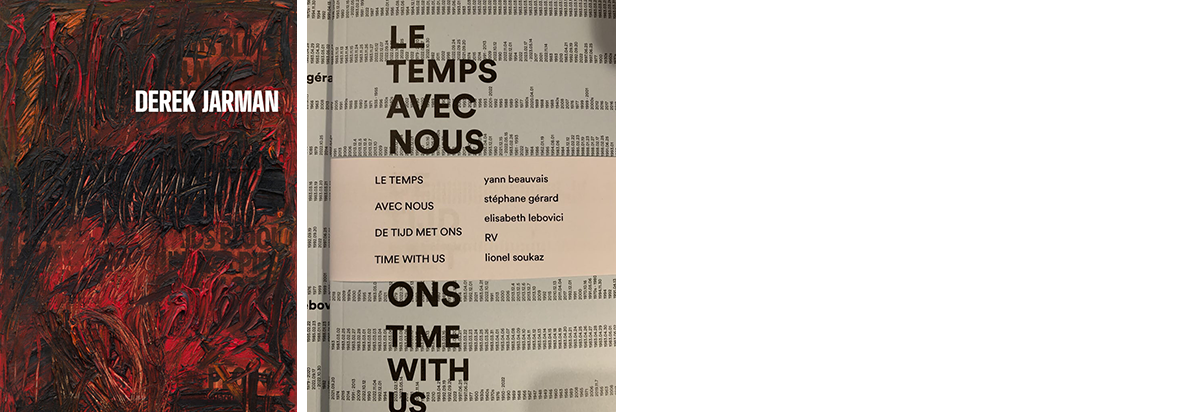
This fall, a new monograph on Derek Jarman will gather newly commissioned essays by international art critics and scholars devoted to specific – and sometimes lesser-known – aspects of the artist’s life and work. Conceived as a reader, Derek Jarman will also include extensive portfolios spanning his successive bodies of works, as well as testimonies by, among others, the actress Tilda Swinton and the musician Simon Fisher Turner and an illustrated chronology. JRP Editions will publish this collection in collaboration with Le Crédac, the center for contemporary art in Ivry-sur-Seine that organized the exhibition “Dead Souls Whisper (1986-1993): Derek Jarman” in 2021.
Of course, Derek Jarman was equally important as a gay activist. One of the works from his militant “Queer Paintings” series (1992) is used as the cover of the latter book. In the Our Story series, the Belgian CINEMATEK focuses on LGBTQIA+ cinema and sets up encounters. Last fall, there was a carte blanche program by yann beauvais and a retrospective of the work of Lionel Soukaz put together by his collaborator and good friend, the filmmaker Stéphane Gérard. In Le temps avec nous/De tijd met ons/Time With Us, CINEMATEK has now gathered the traces of these different encounters with written and drawn, theoretical and poetical contributions by beavais, Gérard, Soukaz, Hervé Couergou and Elisabeth Lebovici. On June 23, Stéphane Gérard will present the book with an accompanying film program at CINEMATEK.
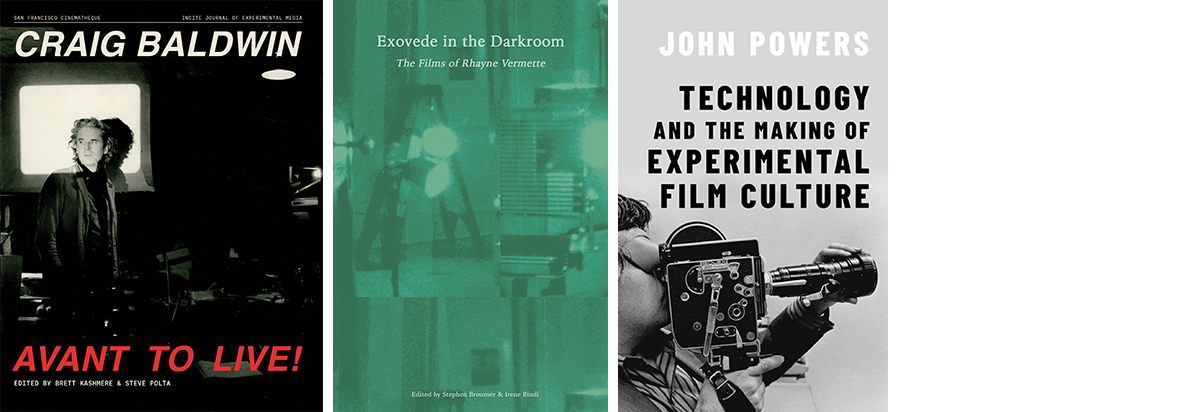
Nearly five years in the making and clocking in at 508 pages, Craig Baldwin: Avant to Live! is the first critical text to document the life and work of the San Francisco Bay Area filmmaker and curator Craig Baldwin. Next to making acerbic, densely packed found footage films, Baldwin is the curator of Other Cinema, an extensive and influential series of film/video programs he has organized in San Francisco on a schedule of thirty-six programs per year since the late 1980s. The book was launched with a retrospective at the end of last month at the San Francisco Cinematheque.
Another first, a collection on the Métis experimental filmmaker Rhayne Vermette has been put together by the artist and editor Irene Bindi and Stephen Broomer, advocate of Canadian underground cinema through his label Black Zero. Published by ARP Books this month, Exovede in the Darkroom: The films of Rhayne Vermette is a series of critical and poetic responses to her work, including one by the Native American filmmaker Sky Hopinka. The title refers to the name that Métis leader Louis Riel gave to his council, a central influence for Vermette. She made a series of powerful shorts. Her feature film Ste. Anne (2021) played at Jeonju, the Berlinale, TIFF Wavelengths, the Viennale and other festivals.
Technology and the Making of Experimental Film Culture takes another, non-auteurist perspective, using technology as a lens for examining the process of making. The experimental film scholar John Powers provides a wealth of new detail about the making of canonized avant-garde classics by such luminaries as Carolee Schneemann, Jack Smith and Stan Brakhage, as well as rediscovering works from overlooked artists such as Chick Strand, Amy Halpern and Gunvor Nelson. The book is forthcoming from Oxford University Press next month.
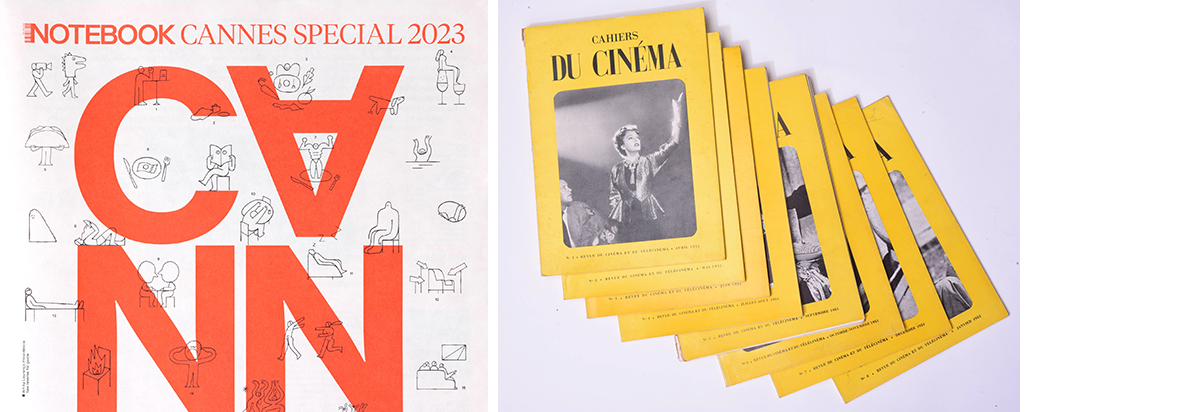
In the field of newly founded film magazines or special issues, it seems much more quiet. While the weather-themed third issue of their Notebook magazine is coming soon, MUBI also put out a limited-edition, print-only Notebook Cannes Special that was exclusively handed out in the streets at the festival or to be found in the Quinzaine totebags. This broadsheet in bright red Pantone color includes interviews with Souleyman Cissé and Alice Roherwacher, festival reflections, an illustration by Joost Swarte, and more.
Cahiers du cinéma will be releasing its 800th issue with its next July-August edition. Have a restful summer and enjoy some good films and books.

